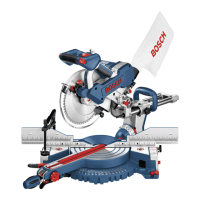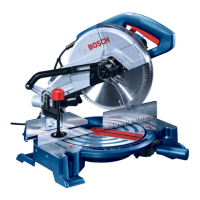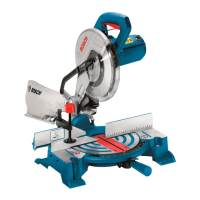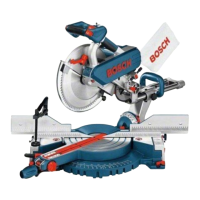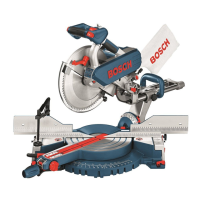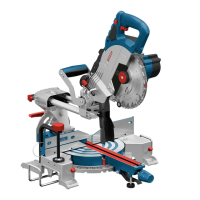English–131 609 929 F69 • (04.10) PS
Cuts without Slide Movement (Cut-off)
(see Figure )
For cuts without slide movement (small work pieces),
loosen the locking screw 29 in case it is tightened.
Slide the tool arm to the stop in the direction of fence
18 and retighten the locking screw 29.
Firmly clamp the work piece as appropriate for its di#
mensions.
Set the desired mitre angle.
Switch on the electro#tool.
Press the button 6 and guide the tool arm slowly
downward with the handle 5.
Saw the work piece with uniform advancing.
Switch off the electro#tool and wait until the saw blade
comes to a complete standstill.
Guide the tool arm slowly upward.
Cuts with Slide Movement
For cuts using the slide rails 23 (wide work piece),
loosen the locking screw 29 in case it is tightened.
Firmly clamp the work piece as appropriate for its di#
mensions.
Set the desired mitre angle.
Pull the tool arm away from the fence 18 far enough so
that the saw blade is in front of the work piece.
Switch on the electro#tool.
Press the button 6 and guide the tool arm slowly
downward with the handle 5.
Saw into the edge of the work piece. Then press the
tool arm in the direction of the fence 18 and saw the
work piece with uniform advancing.
Switch off the electro#tool and wait until the saw blade
comes to a complete standstill.
Guide the tool arm slowly upward.
Adjusting the Depth Stop
(see Figure
)
The depth stop 60 must be adjusted when a butt gap
is to be sawed.
Press the locking lever 41 and swing the tool arm with
the handle 5 to the desired position.
Press the button 59.
Slide the adjustment screw 27 until the end of the
screw rests on the depth stop 60.
Release the button 59.
Guide the tool arm slowly upward.
Sawing Equally Long Work Pieces
(see Figure
)
Loosen the knob 34 and swing the stop 35 up over the
screw 61. Retighten the knob 34.
The stop can be mounted on the saw table extensions
on both sides.
Special Work Pieces
When sawing curved or round work pieces, they must
be especially secured against slipping. At the cutting
line, no gap may exist between the work piece and the
fence or saw table.
In case necessary, a special fixture must be fabricated.
Table Inserts
The red table inserts 10 can become worn after long
use of the electro#tool.
Replace a defective table insert.
Place the electro#tool in the working position.
Screw out the screws 62 with the Phillips screwdriver
provided (see Figure ).
Insert the new left table insert.
Set the vertical bevel angle to 47° (left side).
Press the locking lever 41 and swing the tool arm com#
pletely downward.
Slide the insert to within approx. 2 mm of the saw
blade. Ensure that for the complete length of the pos#
sible back and forth motion the saw blade does not
come in contact with the insert.
Attach the table insert with the screws 62.
Repeat the steps in the same manner for the new right
table insert.
Working with Profile Mouldings
(Floor or Ceiling Mouldings)
Profile mouldings can be worked with two different
methods:
– Placed against the fence,
– Lying flat on the saw table.
In addition, the cut can be performed with or without
slide movement depending on the width of the profile
moulding.
Always make trial cuts with the mitre angle settings
first on scrap wood.
Q
R
S
T
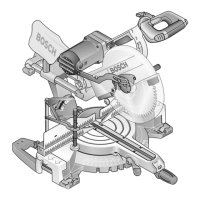
